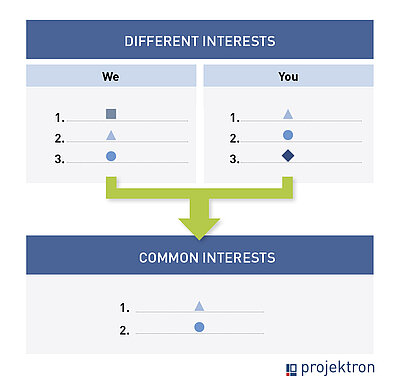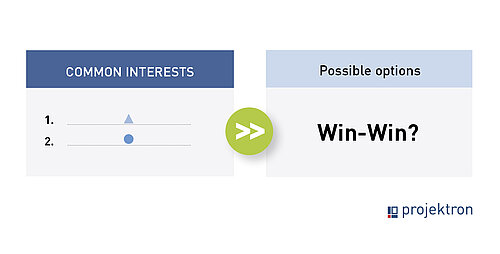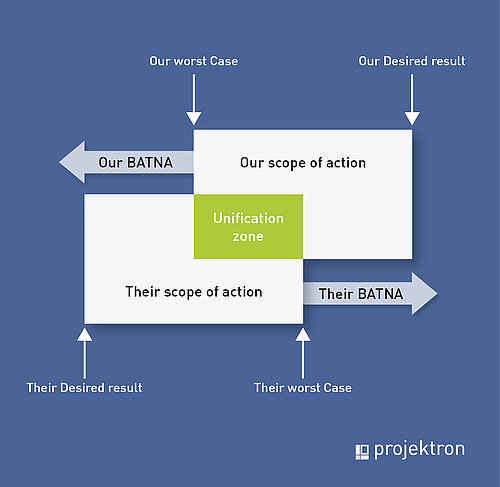06/14/2022 - Articles
Harvard Method: How to achieve win-win situations in negotiations and conflicts
Whether you are negotiating your salary, stuck in contract negotiations with customers, discussing additional requirements in a project with clients, buying a property or agreeing on the next vacation spot with your family - the Harvard Method will help you and create win-win situations. Learn here how the Harvard Method works as a negotiation, conflict resolution and conflict management strategy and how to apply it.
What is the Harvard Method?
The Harvard Method is an approach to fact-based negotiation. It is often referred to as the Harvard Concept, or more rarely as the Harvard Approach, Harvard Principle, Harvard Model or Harvard Technique. The Harvard Method has long since established itself as the standard model par excellence for successful negotiation and conflict resolution. The best thing about the Harvard Method: Both parties to the conflict benefit, because the goal is a constructive agreement, a win-win situation - without any lazy compromises. Conflicts that only end with satisfied parties - who doesn't want that?
The principles of the Harvard Method were formulated by the U.S. lawyer Roger Fisher in 1981 in his work "Getting to Yes," published with William Ury and Bruce Patton. The subject was the Harvard Negotiation Project as part of the "Program on Negotiation" at Harvard Law School of Harvard University. As part of this negotiation program, the Harvard Method was developed as an interest-oriented, constructive and peaceful conflict resolution strategy.
How does the Harvard Method work?
Disputes are decided within the framework of the Harvard principle according to meaning and factual content. The goal is to find out how a difference can be resolved efficiently and constructively. There is no haggling. Neither party to the conflict should be forced into a supplicant position. The method follows four basic principles, also known as the four pillars of the Harvard concept.
The 4 principles of the Harvard Method
- Discuss factually
- Focusing interests
- Develop decision options
- Create objective decision criteria
Harvard Principle #1: Treat people and problems separately!
In the sense of the Harvard method, it is important, similar to the iceberg model in communication, to strictly separate personal relationships and the factual level of the subject of discussion. If this is not done, it can easily happen that a factual statement by party A is perceived by party B as an insult. Personal relationships must first be neutralized or faded out in the sense of the Harvard method, so that a factual negotiation is possible in the first place.
The following aspects will help you to do this:
- Your counterpart is neither your friend nor your enemy. He is an important partner in your problem solving, since a result can only be achieved with the participation of both sides. Calmly tell your negotiating partner that you are convinced that you consider him to be the right person to reach a solution that is fair to both sides.
- Accusations or pointing out subjectively perceived misconduct on the part of the other party lead to a hardening of the fronts, are counterproductive and have no place.
- Articulate your emotions and problems, but do not place the question of guilt.
- State the substantive points/issues clearly and without judgment.
- Formulate your demands and justify them in a comprehensible way.
- Give your negotiating partner room to present his or her concerns in an equally free and well-founded manner. If your counterpart feels understood, he will be all the more willing to pay attention to your concerns.
- Listen and show empathy with your counterpart's position and descriptions.
- Always lead the discussion back to the substantive issues.

Tip
To visualize this abstract principle, the following simple motto helps: Be hard on the subject, but soft on people. The personal relationship with the counterpart should remain intact at all times.
With this strategy, you cause a cognitive dissonance in your counterpart: Your negotiating partner contradicts you on the matter, but on the other hand your counterpart senses human respect, sympathy and trust. This contradiction will ensure that your counterpart is more inclined to accommodate you and also to allow concessions on the factual issue.
Harvard Principle #2: It's about interests, not positions!
Behind every demand there is an interest. The demands are not decisive in the sense of the Harvard method. Rather, you should focus on your own interests and the interests of your conflict or negotiation partner. So first reflect on what your interests are and, if possible, also make a list of your interests before the negotiation.
The Harvard Orange: Interests instead of Positions
To illustrate the concept behind the Harvard Method, the authors of "Getting to Yes" used an older metaphor, the orange example: two sisters fight over an orange. The mother gives each daughter a half. One squeezes the juice from the orange half and discards the peel; the other uses the peel to bake a cake and throws away the pulp. The sisters have the same position, which is "I want the orange." However, this position hides different interests: "I want to drink orange juice" and "I want to bake a cake". If they had explored and formulated the interests, a win-win solution would have resulted.
But what are your interests? That always depends on the concrete individual case of the conflict or negotiation. Interests can basically be:
- Wishes
- Greed
- Fears
- Fears
- Worries
So the question is not "What are we/the other side demanding?" but "Why are we/the other side demanding this?".
Example Harvard Principle #2
A (employee) demands a salary increase from B (his superior). The demand is clear, because it reads "I want more money!". However, A's actual interest is not clear at first.
- Does A want to finance more frequent vacations because he is overworked?
- Does he fear impending poverty in old age because his pension is too low?
- Does he need the money to finance a private caregiver for relatives?
- Does he now have to pay alimony due to a separation?
- Does he want to buy a new car?
- Does he feel that he and his work are not valued enough?
- Does he feel disadvantaged compared to colleagues?
- Does he want to explore his market value because he is thinking of quitting his job soon?
In each of these scenarios, the conflict could be resolved more purposefully and sustainably for both parties if B knew A's real interest and was given the opportunity to show empathy for A's position.
If both would not use the Harvard method and haggle, B will ultimately pay A more salary, but perhaps only half of the demanded amount. A's actual motives remain hidden from B. A may then appear to B to be ungrateful and too demanding, and B may still be dissatisfied despite the salary increase because he still does not feel sufficiently valued.
In this case, the transfer of a responsible project by B to A would have achieved a better result, for example. Only those who know the interests of the other can take them into account.
Therefore, present your counterpart not only with your demand, but also with all your interests openly and objectively.
But that's not all: Consider in advance which interests your counterparty might represent. In the conversation itself, you should ask W-questions to learn more about the demands and the motivations/interests of the other party: "Why are you demanding this?" Positive side effect: Your counterpart will perceive your interest in a productive resolution of the conflict.
Now work together with your negotiating partner. Once both sides have identified and justified their interests, you can group them into different and common interests and list them against each other. This visualization within the framework of the Harvard method helps immensely, as it highlights commonalities and encourages you to specifically address the divergent interests. Good for your relationship management, because along the way you encourage collaboration on common goals.

Interests in harmony
You will find out: It is much easier to reconcile interests than positions and demands. Because usually one interest can be satisfied by different solutions.
Harvard Principle #3: Prepare different alternatives!
An "either-or" decision is not known to the Harvard method. Instead, the Harvard concept suggests a "both/and" variant by looking at different options and achieving your negotiation goal through creativity and flexibility.
Principle #2 already contains the key to this third principle of the Harvard Method. If you have already considered your own goals and the possible interests of your counterpart in advance, it will be easier for you to find alternatives in the case of conflicting positions that take into account the interests of both parties to the conflict or negotiation equally.
Here, do not ask: "What is the right solution?" but choose a creative approach and first brainstorm as many conceivable options and possible solutions as possible. In other words, the question must be, "What solutions would be conceivable?" The conditions:
- The solution paths must serve interests of both parties.
- The solution paths should not be pre-judged and weighted.
- The solution paths must not have one's own interest as the starting point and sole focus point.
Harvard Principle #4: Make an objective decision!
According to the fourth principle of the Harvard Method, you should use objective criteria in the sense of fairness when deciding on a solution path. If you jointly agree on a proposal, both parties involved will feel that they have actively contributed to the decision-making process and that their own interests have been safeguarded - acceptance will be higher.
Present your suggestions developed according to Principle #3 to your counterpart and discuss the pros and cons of the various options together. If your counterpart also submits proposals, you can explore where you have arrived at the same or similar approaches. Measure the various proposed solutions against criteria that are as objective and fair as possible, such as:
- Legal regulations
- Ethical standards/moral criteria
- Applicable quality standards
- Industry conventions
- Comparable cases
- Market value
- Cost
- Reciprocity
- Equal treatment/fairness
The following points should also be considered when making decisions according to the Harvard method:
- The good relations of both negotiating partners are preserved.
- The contents of the chosen decision must be practically implementable.
- Both sides leave the negotiation with at least their minimum goal. If both partners need the same thing, it is shared fairly.
- The negotiation takes place in a time-efficient manner. Positions are not insisted on or argued over.
What to do when the Harvard Method has failed?
If your negotiating partner does not play along or if you do not find both negotiating partners to the desired result despite a negotiation according to the Harvard principles, this is annoying, but not an unforeseen case. According to the Harvard method, you should therefore deal with a possible failure and viable alternatives even before the negotiation: What can you do if, despite the Harvard approach, no agreement is reached?
The authors of "Getting to Yes" call the solution to this situation BATNA, "Best Alternative To a Negotiated Agreement". So, good for you if you have a Plan B in your pocket. If you have thought about your alternative plan in advance, this naturally gives you security in the negotiation and strengthens your position and independence. The more attractive your BATNA, the stronger your negotiating power.
Determine your BATNA as concretely as possible:
- Make a list of possible scenarios.
- Develop options for both sides.
- Also consider what BATNA your counterpart might define.
- Use objective and realistic criteria to determine the chances of success for your BATNA.
If you know your BATNA, you should define your pain threshold accordingly. In other words, the BATNA serves as a safeguard to ensure that you don't inadvertently agree to a solution option that is worse than your own BATNA. Ask yourself what outcome would still be better than your BATNA. If a negotiation threatens to exceed your pain threshold in the direction of the BATNA, interrupt the negotiation and ask for time to think it over.
The Harvard Method: Example from Practice at Projektron
At Projektron GmbH, we use the Harvard method in negotiations with our customers and service providers, but also to resolve conflicts that are unavoidable in everyday collaboration within the Projektron team.
Our negotiation with a customer specializing in logistics processes provides an example of the use of the Harvard concept. Before commissioning the offer, the customer asked for a negotiation meeting on the offer. In the process, we discussed the mutual interests:
| The customer wanted | Projektron wants | |
|---|---|---|
|
| |
| Result | ||
|
Knowing what the customer wanted, we subsequently prioritized features that we could train and configure on site in Hamburg.
Negotiating according to the Harvard method: 3 insights from practice
From my long experience from agreements on settlements, the following three insights are particularly important to me:
1. Effective when talking to the decision makers
The Harvard method is particularly effective when talking to the decision-makers, which in our case are mostly the managing directors of medium-sized companies. This is where the true or long-term interests of the customer are most likely to come to light:
Behind the desire to introduce the software quickly, there is often an interest in ensuring that there is no unrest in the company due to the introduction of time recording. In this case, however, a much more sensible strategy is not to bypass the employees, but to create acceptance through configuration workshops and training. We started introducing the vacation management module in a company with over 500 employees for this reason. Since the existing solution was not particularly popular in the company, the customer's employees were positive about the introduction of our software. The project planning was introduced many months later, much later than originally planned. The duration of the implementation was now no longer an issue.
2. Difficult in negotiations with buyers
Talking to buyers according to the Harvard method usually does not make sense, since they are primarily interested in the price, the payment conditions and the legal framework. Here, negotiating according to the Harvard method would only be useful if you know the advantages and disadvantages of certain regulations in the GTCS, GTPs, VAVs, your own contract documents and similar legal documents like the back of your hand. Then it could happen that the customer waives contractual penalties for missing milestones if he sees his conditions for using the software at subsidiary companies more strongly observed in return. However, such results can only be achieved with a lot of experience in the subject matter. Mere knowledge of the Harvard method is not enough to be successful here.
3. Not applicable for tenders
The Harvard method is usually not applicable to tenders, because there is no personal exchange with the customer. A negotiation according to Harvard would only be conceivable if the customer clearly expresses his interests in the tender documents beforehand or is approachable before the decision is made. Unfortunately, this almost never happens, which is understandable. The customer naturally does not want potential service providers to outdo each other with empty promises. The dilemma we have here is that you can buy materials with tenders, but not complex software that has to be customized.
Conclusion: Disadvantages and Advantages of the Harvard Method
In equal negotiation situations, the Harvard Method offers advantages:
- It is an excellent way to resolve conflicts in a structured manner.
- Both parties achieve negotiation success in the end.
- The relationship of both negotiating parties is strengthened by the practice.
Of course, the Harvard Method has disadvantages:
- It is complex and requires practice.
- It requires some preparation and situational adaptation to the specific conflict case.
- If, in an asymmetrical negotiation, one side has a clear advantage because it has more information or less to lose, the Harvard method cannot be applied meaningfully.
The Harvard method is less suitable for conflicts that arise spontaneously and spontaneous disputes in everyday life. The Harvard method is also not suitable for resolving grievance cases due to the asymmetrical starting situation. In this case, we use complaint management according to the EVA3 methodat Projektron.
Nevertheless, it is worthwhile to get to grips with the Harvard principles and internalize the methods. After all, empathy and a sober, factual and constructive attitude will serve you well in numerous everyday private and professional conflicts. Practice makes perfect: consciously prepare yourself for upcoming negotiations and apply the principles of the Harvard Method in a targeted manner. You will quickly notice that the method not only makes the negotiation climate more positive, but also leads to the desired success.

About the author
The management of Projektron GmbH is currently responsible for more than 110 employees. The Projektron managers defined personal contact with the customer as an essential component of success. Negotiations are naturally on the agenda almost every day. For years, the management has successfully applied the Harvard Method, as it is a non-confrontational method of conflict resolution from which the customer also benefits. Negotiation training according to the Harvard method is therefore also a further training offer for all employees.












